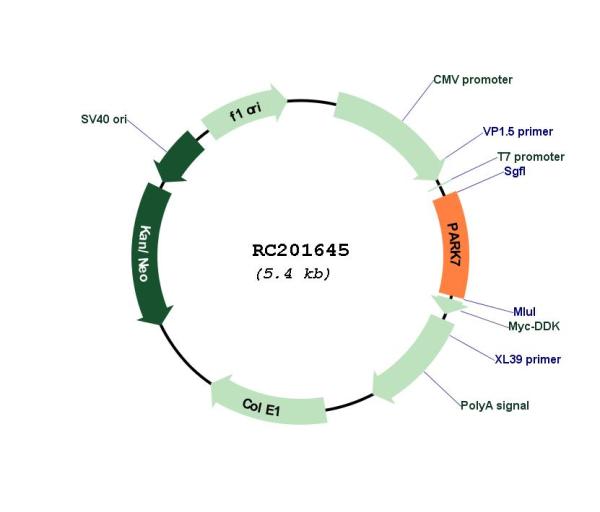PARK7 (NM_007262) Human Tagged ORF Clone
CAT#: RC201645
PARK7 (Myc-DDK-tagged)-Human Parkinson disease (autosomal recessive, early onset) 7 (PARK7), transcript variant 1
ORF Plasmid: tGFP
Lentiviral Particles: DDK DDK w/ Puro mGFP mGFP w/ Puro
AAV Particle: DDK
"NM_007262" in other vectors (6)
USD 198.00
Specifications
| Product Data | |
| Type | Human Tagged ORF Clone |
| Tag | Myc-DDK |
| Symbol | PARK7 |
| Synonyms | DJ-1; DJ1; GATD2; HEL-S-67p |
| Vector | pCMV6-Entry |
| E. coli Selection | Kanamycin (25 ug/mL) |
| Mammalian Cell Selection | Neomycin |
| Sequence Data |
>RC201645 ORF sequence
Red=Cloning site Blue=ORF Green=Tags(s) TTTTGTAATACGACTCACTATAGGGCGGCCGGGAATTCGTCGACTGGATCCGGTACCGAGGAGATCTGCC GCCGCGATCGCC ATGGCTTCCAAAAGAGCTCTGGTCATCCTGGCTAAAGGAGCAGAGGAAATGGAGACGGTCATCCCTGTAG ATGTCATGAGGCGAGCTGGGATTAAGGTCACCGTTGCAGGCCTGGCTGGAAAAGACCCAGTACAGTGTAG CCGTGATGTGGTCATTTGTCCTGATGCCAGCCTTGAAGATGCAAAAAAAGAGGGACCATATGATGTGGTG GTTCTACCAGGAGGTAATCTGGGTGCACAGAATTTATCTGAGTCTGCTGCTGTGAAGGAGATACTGAAGG AGCAGGAAAACCGGAAGGGCCTGATAGCCGCCATCTGTGCAGGTCCTACTGCTCTGTTGGCTCATGAAAT AGGTTTTGGAAGTAAAGTTACAACACACCCTCTTGCTAAAGACAAAATGATGAATGGAGGTCATTACACC TACTCTGAGAATCGTGTGGAAAAAGACGGCCTGATTCTTACAAGCCGGGGGCCTGGGACCAGCTTCGAGT TTGCGCTTGCAATTGTTGAAGCCCTGAATGGCAAGGAGGTGGCGGCTCAAGTGAAGGCTCCACTTGTTCT TAAAGAC ACGCGTACGCGGCCGCTCGAGCAGAAACTCATCTCAGAAGAGGATCTGGCAGCAAATGATATCCTGGATT ACAAGGATGACGACGATAAGGTTTAA >RC201645 protein sequence
Red=Cloning site Green=Tags(s) MASKRALVILAKGAEEMETVIPVDVMRRAGIKVTVAGLAGKDPVQCSRDVVICPDASLEDAKKEGPYDVV VLPGGNLGAQNLSESAAVKEILKEQENRKGLIAAICAGPTALLAHEIGFGSKVTTHPLAKDKMMNGGHYT YSENRVEKDGLILTSRGPGTSFEFALAIVEALNGKEVAAQVKAPLVLKD TRTRPLEQKLISEEDLAANDILDYKDDDDKV |
| Chromatograms |
CHROMATOGRAMS
 Sequencher program is needed, download here. |
| Restriction Sites |
SgfI-MluI
Cloning Scheme for this gene
Plasmid Map

|
| ACCN | NM_007262 |
| ORF Size | 567 bp |
| OTI Disclaimer | The molecular sequence of this clone aligns with the gene accession number as a point of reference only. However, individual transcript sequences of the same gene can differ through naturally occurring variations (e.g. polymorphisms), each with its own valid existence. This clone is substantially in agreement with the reference, but a complete review of all prevailing variants is recommended prior to use. More info |
| OTI Annotation | This clone was engineered to express the complete ORF with an expression tag. Expression varies depending on the nature of the gene. |
| Product Components | The ORF clone is ion-exchange column purified and shipped in a 2D barcoded Matrix tube containing 10ug of transfection-ready, dried plasmid DNA (reconstitute with 100 ul of water). |
| Reconstitution | 1. Centrifuge at 5,000xg for 5min. 2. Carefully open the tube and add 100ul of sterile water to dissolve the DNA. 3. Close the tube and incubate for 10 minutes at room temperature. 4. Briefly vortex the tube and then do a quick spin (less than 5000xg) to concentrate the liquid at the bottom. 5. Store the suspended plasmid at -20°C. The DNA is stable for at least one year from date of shipping when stored at -20°C. |
| Reference Data | |
| RefSeq | NM_007262.3, NP_009193.2 |
| RefSeq Size | 979 bp |
| RefSeq ORF | 570 bp |
| Locus ID | 11315 |
| UniProt ID | Q99497 |
| Cytogenetics | 1p36.23 |
| Domains | DJ-1_PfpI |
| Protein Families | Druggable Genome, Protease |
| Protein Pathways | Parkinson's disease |
| MW | 19.9 kDa |
| Gene Summary | The product of this gene belongs to the peptidase C56 family of proteins. It acts as a positive regulator of androgen receptor-dependent transcription. It may also function as a redox-sensitive chaperone, as a sensor for oxidative stress, and it apparently protects neurons against oxidative stress and cell death. Defects in this gene are the cause of autosomal recessive early-onset Parkinson disease 7. Two transcript variants encoding the same protein have been identified for this gene. [provided by RefSeq, Jul 2008] |
Documents
| Product Manuals |
| FAQs |
| SDS |
Resources
Other Versions
| SKU | Description | Size | Price |
|---|---|---|---|
| RC201645L1 | Lenti ORF clone of Human Parkinson disease (autosomal recessive, early onset) 7 (PARK7), transcript variant 1, Myc-DDK-tagged |
USD 600.00 |
|
| RC201645L2 | Lenti ORF clone of Human Parkinson disease (autosomal recessive, early onset) 7 (PARK7), transcript variant 1, mGFP tagged |
USD 600.00 |
|
| RC201645L3 | Lenti ORF clone of Human Parkinson disease (autosomal recessive, early onset) 7 (PARK7), transcript variant 1, Myc-DDK-tagged |
USD 600.00 |
|
| RC201645L4 | Lenti ORF clone of Human Parkinson disease (autosomal recessive, early onset) 7 (PARK7), transcript variant 1, mGFP tagged |
USD 600.00 |
|
| RG201645 | PARK7 (tGFP-tagged) - Human Parkinson disease (autosomal recessive, early onset) 7 (PARK7), transcript variant 1 |
USD 500.00 |
|
| SC115623 | PARK7 (untagged)-Human Parkinson disease (autosomal recessive, early onset) 7 (PARK7), transcript variant 1 |
USD 300.00 |
{0} Product Review(s)
Be the first one to submit a review






























































































































































































































































 Germany
Germany
 Japan
Japan
 United Kingdom
United Kingdom
 China
China




